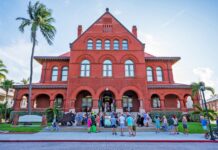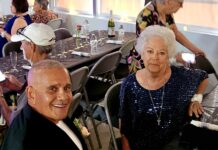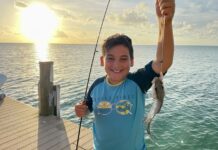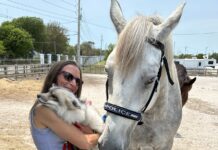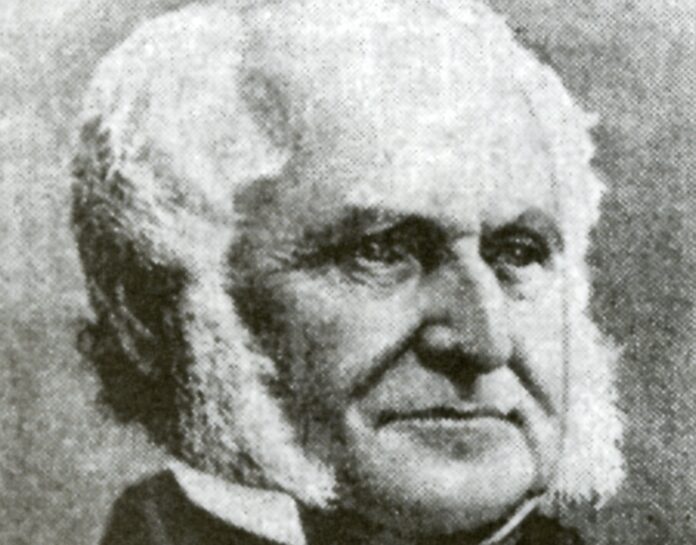Key West’s Whitehead Street is named after John Whitehead, who once owned a one-quarter interest in the island. John introduced his younger brother William to the island, where both brothers left their mark.
William arrived on the island in 1828, and served the community both civically and politically. In 1829, he was hired to complete the first official survey, and mapped the island in a grid-style layout that created and named many of the streets still recognized today – including Whitehead Street. His survey platted the island equally among the island’s four owners: John Simonton, Pardon C. Greene, John Fleming (originally spelled Fleeming), and Whitehead’s older brother John.
The younger Whitehead did more than map the island; among other appointments, he was an early collector of customs and, in 1830, was in charge of Key West’s port of entry. William was also something of a writer who penned his “Reminiscences of Key West,” which ran serially in the Key West newspaper Key of the Gulf in 1877.
William Whitehead wrote an interesting story or two about Dr. Waterhouse, a Vermont doctor who hoped that the warmer climate of the West Indies would better suit the fortification of his failing health. He left his wife and son, booked passage to Key West, and arrived in August 1828.
One story occurred on April 1 – the exact year was left unidentified, but it was before 1835. According to Whitehead’s account, Dr. Waterhouse kept a bulletin board outside his Key West office where the public could post questions, concerns or alert the doctor to the need of a house call. On that first day of April, a note was pinned to the board that was seemingly authored by Judge Webb. It stated that he was in need of a visit to address some discomfort from a bad tooth.
Waterhouse read the note, grabbed his medical bag and took the walk down Whitehead Street, as it would so happen, to Webb’s home. The doctor stopped, faced the door and rapped on the wood with his knuckles – knock, knock, knock. When the judge answered the door, the two exchanged pleasantries. Waterhouse inquired about the condition of the judge’s tooth.
Surprised by the question, Webb responded that his teeth were fine. Confused, Waterhouse presented the note that led to the house call and asked Webb for an explanation.
The judge explained, “It means, doctor, that this is the first of April.”
A second story recorded by Whitehouse addressed Dr. Waterhouse, the person, more directly: “Though quiet and shy socially, he could exhibit ironic repartee when the occasion demanded. He occasionally attended suppers at which it was the custom for guests to entertain by singing a song, playing an instrument or telling a story. It was a custom in which Dr. Waterhouse politely but steadfastly declined to participate. On one occasion, young district attorney Chandler demanded a story from the doctor. After many refusals, the doctor finally succumbed, and told the story of the thief who embarked on robbing a church, but got trapped and discovered that his only way out was a high window in the belfry. In order to reach the window he had to climb the bell rope, and in doing so he rang the bell, alerting the townspeople, who descended on the church and caught him.
“The doctor had a habit of holding his forefinger on his nose as he spoke, and the guests were wondering where this seemingly pointless story was going. The doctor continued, ‘As they were leading him away,’ taking his finger from his nose and pointing it at the district attorney, ‘the thief turned around and addressed the bell, as I do you now, Mr. Chandler, saying, ‘If it had not been for your long tongue and empty head I would have escaped.’”
In the meantime, Dr. Waterhouse decided it was time to make efforts to move his family by his side. He sent for his wife and son in Vermont, and they packed up their belongings. Passage was booked to the West Indies, to Key West and their new island home. While his son weathered the trip from Vermont without incident, the same could not be said about Mrs. Waterhouse, who fell ill during her trip and never fully recovered. She died in 1832.
The doctor and his son relocated to Indian Key in late 1833 or early 1834. The arrival of a doctor, a permanent resident, must have made him a welcome addition to the island’s growing population. Tragically, Waterhouse’s time at Indian Key was short-lived.
A story in the Key West Register, dated Jan. 24, 1835, read: “On Saturday last about 9 o’clock p.m. a rumbling noise was heard in a W.N.W. direction from this place and in a short time a violent rush of wind followed which continued near 10 minutes with greater force than has ever been felt here for many years. The schooner Fair America was blown upon the beach, near Browne’s wharf, and several boats were injured. To windward the blow was sensibly felt and some damage done, and several lives lost, among which we lament to mention the drowning of Dr. H.S. Waterhouse and his little son near Indian Key.”
The followup to the story was more definitive. “Dr. Henry S. Waterhouse and his son, residents of Indian Key, left the island on Saturday Evening the 17th instant in a boat on an excursion of fishing. The following morning it was discovered that they had not returned — boats were immediately dispatched in search of them; the boat in which they went was very soon discovered bottom upwards, and on further examination during the day, the body of the doctor was found and brought to this island, this day interred. No discovery has yet been made of his son. It is the general opinion that the boat capsized in a very severe squall which occurred during the evening they left the Key.”

